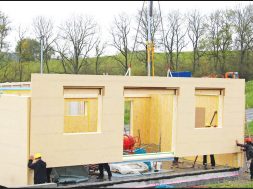Energy-efficient buildings WHY & HOW?
Achieving the common goal of sustainability and awareness for energy-efficient structures isn’t difficult anymore
Energy efficiency is the first big step towards achieving sustainable buildings. Energy efficiency helps control rising energy costs, reduce environmental footprints, and increase the value and competitiveness of buildings. No wonder the demand for energy efficiency is accelerating rapidly. There are several examples where the existing buildings are retrofit with new energy-efficient solutions as well as adopting solar power. Even the green building movement has further given a boost to these initiatives.
Criteria of an energy-efficient buildingEnergy Performance Index (EPI) is the first parameter to assess the energy performance of a building. The lower the EPI, the more efficient the building is. According to Saurabh Kumar, Managing Director, Energy Efficiency Services Ltd., “The buildings’ EPI assessment coupled with a quick assessment of the equipment in use, done through a walk through to ascertain possible areas of higher energy consumption or energy wastages, together leads to assessment on the energy performance of the building. All such areas that need energy optimisation are detailed out through studies that also focus on the need for technology upgrade and automation.”
Even Rumi P Engineer, Head – Green Building Consultancy Services and Energy Conservation, Godrej & Boyce Mfg. Co. Ltd., thinks the same. He says, “In order to judge whether a building is energy efficient or not, one needs to have sub-system level energy data, map the trend, and work out the Energy Performance Index (EPI) as per the BEE norms.”
Rumi also adds, “Equipment level as well as system level energy efficiency need to be worked out and compare with the design efficiency which will help determining the energy-efficiency performance of the building.”
Perfect design of energy-efficient buildingsDesigning is the key to achieve an energy-efficient building. Most cost-effective steps towards a reduction in a building’s energy consumption usually occur during the design process. “Design of an energy-efficient building needs to be done from the point of view of optimal life cycle costs, not the first cost,” says Saurabh Kumar, Managing Director, Energy Efficiency Services Ltd. “Many aspects of a building’s performance depend on design stage interventions. Space cooling requirements can be reduced to nearly half through judicious orientation of the building, ensuring maximum natural ventilation, use of shades, insulation and high U-value glass for windows and doors. Use of artificial lighting can also be mitigated through use of natural lighting through high U-value windows, glazed films and sun roofs.”
According to Rohit Mahajan, Head of Design, Emaar MGF Land Ltd., “A most cost-effective energy efficient solution can be achieved if it is made an integral part of the design basis starting from the project. Appropriate passive architecture techniques, sun path analysis, orientation, and climatic responsive envelope design are measures which can contribute to a great extent if applied at the right stage.”
However, Rumi thinks there is nothing as perfect design for energy efficiency. “It is contextual,” he remarks. “One has to understand the end-use application of the building and appropriate design needs to be worked out. Design stage is the very crucial to build in energy efficiency in the project. It is an integrated approach, wherein all the stakeholders (client, architect, MEP design consultant, PMC) play important roles in aligning the design inputs.”
‘Energy harvest’ vs ‘energy conservation’Energy conservation is reduction in end-use energy, whereas energy harvesting is making use of natural resource for end use energy. “Energy conservation and energy harvest both goes hand-in-hand,” remarks M. Anand, Principal Counsellor, CII-IGBC. “Energy conservation is about consuming or utilising energy in an efficient way and energy harvest is about generating renewable energy.”
According to Mahajan, both have their own significance. He says, “Energy conservation is foremost with the aim being to reduce the per capita energy consumption. Energy conservation can be achieved by using it with care and efficient technologies. Energy harvest is the only solution to meet the future energy needs.”
Passive solar buildingsThere has been a tremendous change in the energy consumption pattern of buildings across the world. Since the 1980s, passive solar building design and passive house have demonstrated heating energy consumption reductions of 70-90 per cent in many locations. Not only a robust building envelope design can go a long way in curtailing the heat gain in the building, it also substantially reduces energy demand of air-conditioning system — be it commercial or residential project.
However, passive solar building isn’t a new concept in India. “The design of passive solar building is deep rooted in our history,” shares Mahajan. “Our ancestors were mastered in the art of passive solar architecture. We are adopting our old-age techniques for designing modern buildings with an amalgamation of new innovations in technologies.”
Even Anand confirms that the concepts of passive solar building design were practiced since long back, even before the advent of mechanical heating and cooling. He shares, “It remained as a traditional part of vernacular architecture. In third century BC, during Indus Valley Civilisation, a lot of evidences demonstrate that they have considered factors such as solar orientation, thermal mass and ventilation while designing the residences.”
Challenges to develop energy-efficient buildingsAchieving energy efficiency in building poses several challenges. “The major challenge in building a highly energy-efficient building is the reluctance of client to spend the additional set-up cost,” says Architect Surinder Bahga. “Another challenge is the bye-laws and non-availability of proper trained and aware workmanship.”According to Kumar, “There are broadly two reasons for the slow adoption of energy efficiency in our country: technical and financial. In a scenario where multiple functions compete with one another for financial allocation, the financial resources available with building managers to undertake energy-efficient projects are rather limited mostly due to the fact that such investments often payback in a time frame not commensurate with the financial planning.
IGBC, BEE and EESL are all working to turn around these impediments. With Green Building Rating System, IGBC is helping buildings sustain energy-efficient practices over the life of a building. BEE is working towards incorporation of energy-efficiency parameters in the building bye-laws and building stakeholders’ capacity by training architects on ECBC, certifications and other relevant trainings, whereas EESL has been doing projects on ESCO mode that circumvent the need for first cost to finance energy-efficient projects that payback using the accrued energy cost savings.
Sustainability and energy efficiency are the 21st century buzzword. We only need to educate the market about the benefits of energy-efficient buildings. Once the technology and material are locally available and pricing become competitive, energy-efficient buildings will be widely accepted.
9
Cookie Consent
We use cookies to personalize your experience. By continuing to visit this website you agree to our Terms & Conditions, Privacy Policy and Cookie Policy.









